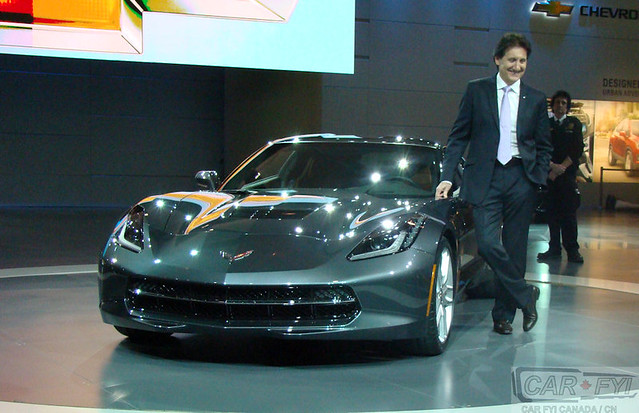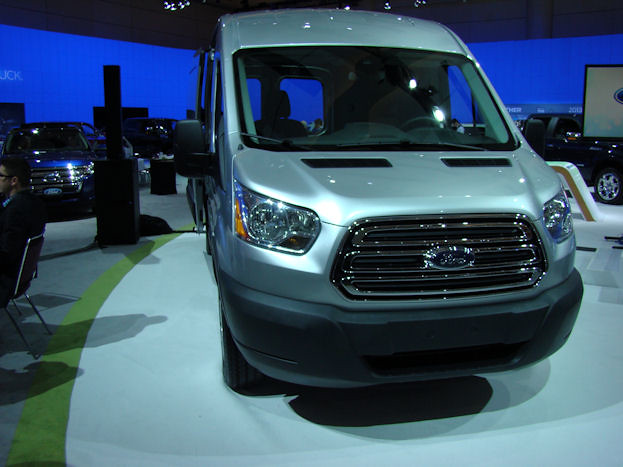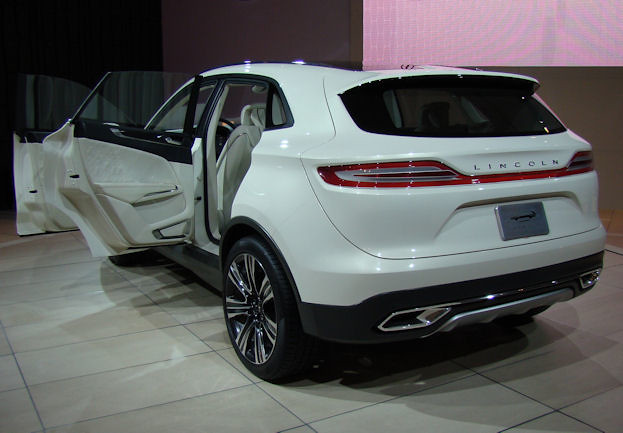 |
| Photo Credit: Car FYI Canada/Chris Nagy |
Theme of the Show: 40th Anniversary- The Legacy
The Canadian automotive landscape had certainly changed over a 40-year time span (at least that would be my impression despite the fact I wasn’t alive in 1974). The brands, the technology and the diversity in vehicle types present two different worlds of motoring.
The 2013 Canadian International AutoShow marked four decades of collecting the latest vehicles under a roof during the middle of winter. Humbly started as an exhibition in the International Centre near Pearson International Airport by a local Toronto dealership organization, the modern incarnation of the car show consumed the floor of the Metro Toronto Convention Centre by the time the 40th edition of the show was held.
As one final note worth mentioning about the 40th edition of the Canadian International AutoShow, Media day occurred on Valentine’s Day so it was an occasion where I spent time with a love in my life.
Notable Vehicles:
2014 Chevrolet Corvette Stingray
 |
| Photo Credit: Car FYI Canada/Chris Nagy |
Ford Transit
 |
| Photo Credit: Car FYI Canada/Chris Nagy |
In North America and Europe, Ford was a steady leader in the commercial van segment over the course of decades. Ford’s foothold in both continents was achieved with two completely different vehicles. Starting in 1960, the Econoline nameplate became the staple for the blue oval’s vans sold in the United States and Canada. Going by the E-Series in its later years, the North American full-sized van’s final generation model was introduced for the 1992 model year and received several styling and equipment updates by the time 2013 started. For the 2015 model, Ford would conclude production of the passenger and cargo van E-Series line replacing it with European flavour. A familiar name on the eastern side of the Atlantic Ocean, the Transit moniker would be associated with Ford’s newest work hauler in Canada incorporating a unibody frame, a high roof option as well as the choice of an EcoBoost V-6 engine.
Hyundai HCD-14 Genesis Concept
 |
| Photo Credit: Car FYI Canada/Chris Nagy |
I guess you have heard the saying or a variation of the phrase “your first impression is your best impression”. Personally, first impressions are frequently unreliable and I have been presented with plenty of evidence only that only confirms it. When automaker Hyundai entered the Canadian market in 1984 (arriving almost two years before they entered the United States) their goal was to undercut the competition on price. Gaining the reputation as a budget car builder thanks to strong Canadian sales for the Pony, Hyundai products would eventually be branded with sketchy reliability. The South Korean automaker spent considerable resources to rehabilitate their earlier image by first improving vehicle build quality and later rising the premium content in the product lineup. In late 2015, Hyundai Motor Company would dive fully into the luxury car market creating the Genesis brand. Prior to the introduction of the new premium marque in 2013, Hyundai unveiled an exquisite design known as the HCD-14 Genesis Concept. The concept’s attractive grille and coupe-like roof and tail section previewed the exterior style that would be exercised in the creation of the vehicle to be known as the Genesis G80 sedan. Driver eye-tracking technology as well as hand gesture recognition for controlling interior amenities was also included inside the HCD-14 Genesis Concept.
Acura NSX Concept
 |
| Photo Credit: Car FYI Canada/Chris Nagy |
At last year’s Toronto auto show, Acura attracted a massive crowd by showing off a concept for an upcoming revival of the NSX nameplate. This 2012 Acura NSX Concept was mainly a mock-up hinting at the exterior aesthetics but left a lot to the imagination. In the 2013 showing of the upcoming NSX supercar, the Canadian audience got to see full prototype with a detailed interior incorporating a two-tone colour scheme fashioned around what the luxury car brand called “Human Support Cockpit” theme. Greater specifics on the components that will be found in the hybrid sport machine with the arrival of the 2013 concept. The latest concept example detailed propulsion as an Acura Sport Hybrid SH-AWD (Super Handling All-Wheel Drive system featuring a V-6 gasoline engine, three electric motors and control through a dual-clutch transmission.
BMW i3 and i8 Concepts
 |
| Photo Credit: Car FYI Canada/Chris Nagy |
Back in 1974, audiences of the Canadian International AutoShow were treated to the sight of a BMW 3.0 CSL coupe that won the 1973 European Touring Car championship. The 3.0 CSL was specially constructed to be lightweight racing machine using thinner steel, aluminum alloy body panels as well as fiberglass front and rear spoilers. Just 1,265 examples of the weight-optimized BMW were built in order to qualify it as a production car making it a precious collector’s item. Starting in the 2010s, BMW would apply similar ingenuity used to construct the 3.0 CSL to unleash their new electrified motoring image. Launched as a sub-brand of BMW in 2011, the BMW i would be used as an enterprise involving the introduction of vehicles that would be known as the i3 and i8. Unveiled to Canada in concept form in 2013, the two vehicles representing a compact car and sports car would employ lightweight yet strong carbon fiber reinforced polymers in a manner applied more consistently to high-performance exotic cars. The use of lighter weight materials on the exhibited BMW i3 and BMW i8 concepts would optimize their electric range. The BMW i range of vehicles was launched to the public in 2014 and would play a major role in BMW Group reaching half a million in worldwide electrified vehicle sales in 2019.
Audi RS7
 |
| Photo Credit: Car FYI Canada/Chris Nagy |
Introduced for the 2011 model year, the Audi A7 Sportback provided the German premium brand’s customers a vehicle option that fuses the qualities of various automotive segments. Featuring enough similarities to the popular A6 sedan allowing it to effortlessly boast itself as a sophisticated and comfortable cruiser, the A7 Sportback’s unique touches highlighted by its fastback profile gave the vehicle a more provocative sport design that also supported added cargo space. Unveiled a month earlier at the North American International Auto Show, the latest and more powerful iteration of the well-received Audi arrived in Toronto. The 2014 Audi RS7 Sportback received an intelligent, twin-turbocharged 4.0-liter V-8 engine that generated a monstrous 553-horsepower roar. The potent engine combined with a seven-speed dual-clutch transmission and connected to a quattro all-wheel drive could send the RS7 Sportback from 0 to 60 in 3.6 seconds. LED lighting and an RS trim specific interior were also included on the high-performance Audi fastback.
Cadillac ELR
 |
| Photo Credit: Car FYI Canada/Chris Nagy |
Part of General Motor’s display at the first Canadian International AutoShow in 1974 consisted of the XP-883 experimental urban vehicle. The compact commuter car weighted roughly 2,100 pounds and featured seating for two adults and a second set of rear-facing seating explicitly explained as for children. General Motors’ XP-883 experimental vehicle was powered by a hybrid powertrain combining a two-cylinder gasoline engine with an electric motor fed by six 12-volt batteries. While the XP-883 never appeared to have been a serious production possibility, the new General Motors had begun to regularly produce hybrid vehicles 40 years later. On the market for several years, the Chevrolet Volt plug-in hybrid provided the automaker more of a publicity tool than a game-changing vehicle due in large part to a starting price exceeding $40,000 in Canada prior to applicable government incentives. Appearing as a prudent measure to reacting to the higher expense of plug-in hybrid drive technology, General Motors decided to use the Volt’s platform for a Cadillac-branded coupe. The 2014 Cadillac ELR featured styling derived from the 2009 Converj concept car that largely concealed its roots to the electrified Chevrolet sedan. Produced between the 2014 and 2016 model years, Cadillac’s first plug-in hybrid barely made a dent in the growing electrified luxury car category with a nearly $80,000 Canadian base price a key factor. Only 44 Cadillac ELRs were sold in Canada over its three-year production run.
Lexus LF-LC
 |
| Photo Credit: Car FYI Canada/Chris Nagy |
Lexus entered the 2012 calendar year with many examples of a carbon fiber-laden, V-10 powered LFA supercar finding fortunate customers. On the same year as the 500-vehicle production run of the LFA ended, Lexus teased crowds at the Detroit auto show with the shape of a stunning 2+2 passenger concept. By no means a direct replacement to the LFA, the Lexus LF-LC did exhibit itself to be an infectiously shaped, driver-focused coupe. Created by the talents of Lexus’ Calty design studio, the LF-LC featured, to date, some of the most exaggerated use of the company’s sharp L-shaped exterior details with headlights, grille and side intakes and taillights boldly defined on the concept. The design also boasted minimized roof pillars creating a largely glass greenhouse for the occupant of the Lexus LF-LC concept. The LF-LC sport coupe design was based around what would be a new Lexus hybrid drive system. For the 2018 model, the image of the concept car shown at the 2013 Canadian International AutoShow would heavily translate into the Lexus LC that included the hybrid-powered 354-horsepower LC500h.
Toyota Fun VII Concept
 |
| Photo Credit: Car FYI Canada/Chris Nagy |
Words that would often describe the vehicles of the Toyota auto company would include practicality, economy and reliability. In some cases, Toyota’s effectiveness in selling automobiles to a worldwide customer base has also caused the word ‘boring’ to be used as their efforts to create everyday vehicles can lead to safe, non-threatening designs. However, attendees of auto shows would often be given a different prospective of the Japanese-based automaker as capable of imagining some radical motoring concepts. For the 2013 Canadian International AutoShow, Toyota brought what could be seen as a futuristic, customizable moving billboard. At a length of 4,020 millimeters with a wedge-like profile, the Toyota Fun-VII was a three-passenger surrounded by body panels acting as a massive viewing screen. Practically any imaginable colour, image or design could be placed on the Fun-VII’s exterior with the ease of a smartphone download. The interior of the concept was equally tech-savvy with a voice interface and a navigational system that utilizes augmented reality.
Lincoln MKC Concept
 |
| Photo Credit: Car FYI Canada/Chris Nagy |
At the time of the 1974 auto show in Toronto, Lincoln’s product lineup consisted of the 228.4-inch (5,801.36 millimeter) long Continental Mark IV coupe and the Continental sedan measuring 232.6 inches (5,908.04 millimeters). By 2013, even the full-sized, truck-based Lincoln Navigator measured shorter in overall length than the luxury car company’s land yachts of 40 years prior. Part of Lincoln’s 2013 presentation at the 2013 Canadian International AutoShow included what would eventually become the brand’s shortest production vehicle. Based on the platform of the Escape, the MKC Concept was a well-executed transfer of Lincoln’s modern image on a compact crossover featuring striking LED headlights, panoramic roof and an interior positioned in a four-passenger layout. The thinly-veiled concept would be added to the Lincoln lineup as the MKC in 2015 measuring 179.3 inches (4,554.22 millimeters) in length.
2013 Mercedes-Benz G63 AMG (Gold Wrapped)
 |
| Photo Credit: Car FYI Canada/Chris Nagy |
During the inaugural Canadian International AutoShow at the International Centre, a main attraction was a Mercedes-Benz C-111 experimental concept car. Never becoming a production car, the C-111 would gain considerable attention as a stylish, powerful aerodynamic Mercedes-Benz test bed. Appearing in its third iteration trim for the 1974 Toronto show, the Mercedes-Benz C-111 was equipped with a Wankel/rotary engine projected to generate 400 horsepower. For the 2013 Canadian International AutoShow, attention inside the Mercedes-Benz display was drawn to a G 63 AMG sport utility vehicle. Operating with a full-time four-wheel drive managed with three electronic locking differentials, the Mercedes-Benz G 63 AMG received a 544-horsepower, 5.5-liter biturbo engine. A luxury vehicle fetching close to $150,000 Canadian, the shiny gold exterior of the G 63 AMG at the 2013 show was fitting.
SRT Viper
 |
| Photo Credit: Car FYI Canada/Chris Nagy |
As Chrysler Group emerged from its 2009 bankruptcy, the auto company almost immediately created two vehicle brands in addition to the Chrysler, Dodge, Jeep and the addition of Fiat. In 2010, the Ram pickup truck was separated from Dodge and would later expand to its own brand lineup that would include Fiat Group derived ProMaster and ProMaster City vans. A second, short-lived brand born out of Dodge arrived from the brand’s Street & Racing Technology better known as SRT. Helmed by Canadian Ralph Gilles, the SRT division was intended to feature a sizable lineup of sport-tailored vehicles but was only able to bring one car to the market. Gaining Chrysler’s third generation Viper supercar, the all-new 2013 model year touted greater performance potential than its previous incarnation. Characteristics of the 2013 SRT Viper included an 8.4-liter V-10 engine generating 640 horsepower and 600 lb-ft of torque, chassis with 50 percent greater torsional stiffness, an available two-mode suspension system as well as an interior featuring Uconnect Access with an 8.4-inch touchscreen. This latest version of the Viper was strictly sold as a coupe throughout its production run from 2013 to 2017. Despite rumours of future products including revival of the Barracuda nameplate, SRT would be last down in the middle of 2014.
Special Exhibitions:
Auto Exotica
 |
| Photo Credit: Car FYI Canada/Chris Nagy |
The third year as a part of the Canadian International AutoShow, Auto Exotica once-again held a valuable collection of new and vintage machines. Some of the highlights of the 2013 display were a McLaren MP4-12C Spider, Maserati MC12, several Callaway Corvettes and an Alfa Romeo 8C Competizione. Auto Exotica also contained two exceptional Ferrari competition cars. A Ferrari 333 SP prototype sports car and a Ferrari 640 car that Nigel Mansell would have competed in during the 1989 Formula 1 season were positioned beside each other.
Eco-Drive Showcase
 |
| Photo Credit: Car FYI Canada/Chris Nagy |
Promoting motoring solutions that explores alternatives to gasoline or extends the consumption of a gallon of gasoline, the CAA sponsored Eco-Drive Showcase was a small but important gathering of electric and hybrid vehicles. Besides the Nissan Leaf and Smart Fortwo electric drive, the showcase included a uniquely Canadian vehicle. Created in a two-year collaboration between Toronto Electric and University of Toronto professor Olivier Trescases, the A2B was an experimental electric car designed and constructed in Canada.
Cruise Nationals
 |
| Photo Credit: Car FYI Canada/Chris Nagy |
Narrowing down a collection of 60 beautiful vehicles discovered at cruise events across Southern Ontario to 10 finalists, the 2013 Cruise Nationals at the Canadian International AutoShow featured classically stock and custom automobiles. For 2013, it the honours of the Cruise Nationals top prize was claimed by the Mopar brigade. A Mopar vehicle took top honours for Cruise Nationals. Fiona and Robert Young’s yellow/black 1971 Plymouth ‘Cuda 383 was the 2013 Gold medal winner ranking above Kevin Saindon’s 1939 Ford Roadster and a 1956 Ford Thunderbird owned by Teresa and Jason Villari.
Hot Rod: Canadian Builders Showcase
 |
| Photo Credit: Car FYI Canada/Chris Nagy |
Unrelated to the Cruise Nationals event, the Canadian Hot Rod Showcase presented by Castrol gave attendees of the 2013 Canadian International AutoShow an opportunity to see some truly creative custom cars and trucks. Some examples of note included a 1939 Chevrolet Bell Telephone Service Truck prepared by Dream Machines Ltd of Toronto, a 1968 Chevrolet Camaro with a 502 cubic-inch V-8 engine created by Boot Hill Automotive Resurrection and Oddball Kustoms 1932 Buccioli called “The Bootch”. Also exhibited with the display was a BASF-owned Mercedes-Benz 300 SL Gullwing that was custom prepared by Chip Foose.
Sport Compact Evolution
 |
| Photo Credit: Car FYI Canada/Chris Nagy |
A special exhibition located on the same floor of the Metro Toronto Convention Centre as the Hot Rod: Canadian Builders Showcase that involved many cars from the 1930s to 1960s, Sport Compact Evolution gave attention to later model machines. Honda-badged NSX supercars, a wildly styled Scion FR-S and a Renault Clio race car were along the thrilling examples of modern performance tastes.

Comments
Post a Comment